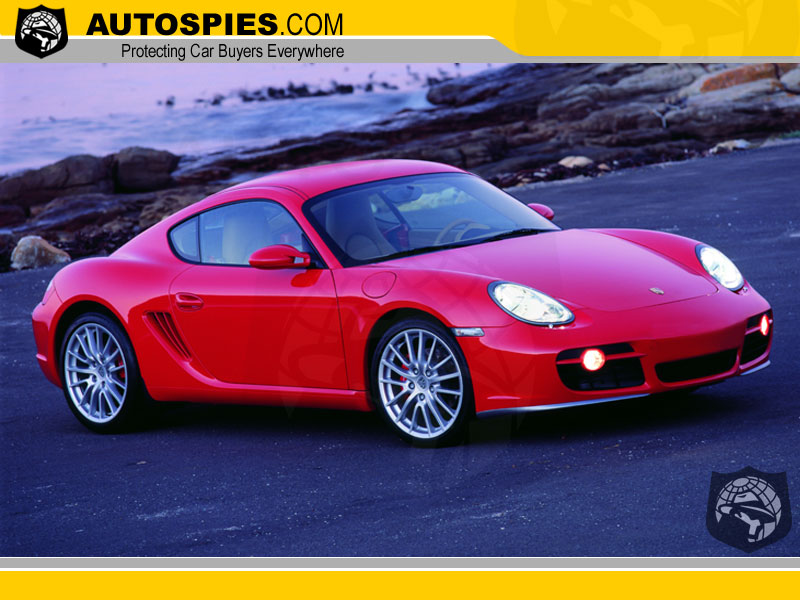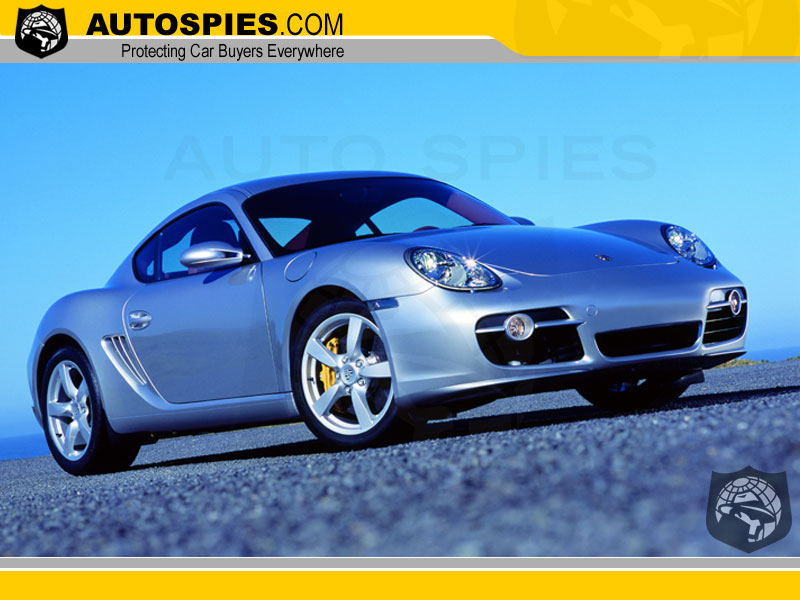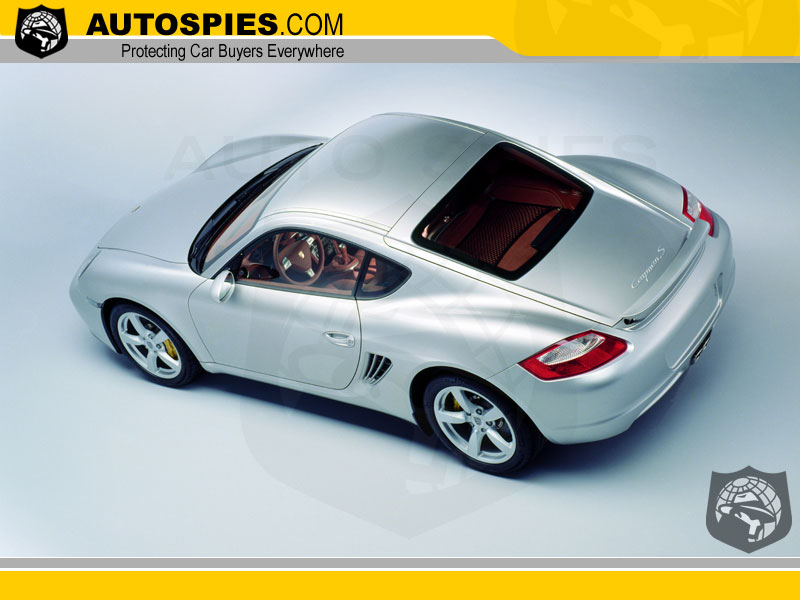Boxster-based two-seat coupe gets larger, more powerful engine and puts it in a gorgeous and aerodynamic package

A new and Boxster®-based coupe joins the Porsche sports car lineup for 2006, and while this vehicle shares much with the acclaimed roadster, its unique characteristics and exceptional dynamic capabilities earn it the right to its own name — the Cayman S.
With its larger and more powerful 3.4-liter, horizontally opposed six-cylinder engine and its lightweight but extremely rigid chassis riding on a nimble suspension, the 2006 Porsche Cayman S sets the benchmark in the two-seat sports coupe category.
In testing around Germany’s famed Nürburgring racing circuit, the Cayman S turned laps that rivaled even the acclaimed Porsche 911 Carrera.
Yet because of careful engineering for optimizing weight and a design that provides outstanding aerodynamics, the Porsche Cayman S also set new standards on the famed Northern Circuit for turning the fastest lap while using the least fuel.
With its combination of a powerful drivetrain, exceptionally well-balanced dynamic dexterity and the quality of braking that characterizes all Porsche vehicles, the performance by the Cayman S on Germany’s most demanding closed circuit resulted in lap times some 15 seconds faster than the closest of its rivals in the two-seat coupe category.
But the Cayman S is more than a performance car. It also was designed to be comfortable and well appointed for long-distance driving, whether on two-lane mountain roads or wide-open stretches of Interstate highway with a well-equipped passenger compartment.
Powerful but fuel-efficient 3.4-liter engine
Providing power for the 2006 Porsche Cayman S is a new 3.4-liter “boxer” six-cylinder engine. While based on the 3.2-liter engine in the 2006 Porsche Boxster S, this engine wears the cylinder heads and uses the same VarioCam® Plus technology as the venerable Porsche 911 Carrera. VarioCam Plus carefully camshaft and valve lift and constantly makes adjustments to optimize power output. The 2006 Porsche Cayman S is the first car other than the 911 Carrera to benefit from this unique Porsche technology.
The engine thus punches out 295 horsepower and 250 foot-pounds of torque, propelling the Cayman S from a standing start to 60 miles per hour (96 km/h) in just 5.1 seconds. The car reaches 99 mph (160 km/h) in a mere 11.7 seconds and gets to 124 mph (200 km/h) in 18.6 seconds. The car eclipses the quarter-mile sprint in 13.6 seconds and achieves a top speed on the test track of nearly 171 mph (275 km/h).
However, the Cayman S is rated at approximately* 19-mpg city and 27-mpg on the highway (12 liters/100 km city and 8 liters/100 km highway). The engine’s efficiency also shows in its emissions as it qualifies as an LEVII (low-emission category two) vehicle in the United States.
In internal testing, Porsche engineers found that the Cayman S engine makes 15 more horsepower than the powerplant in the Boxster S, yet over the course of 62 miles (100 kilometers) traveled used only four-tenths of a pint more gasoline.
In addition to its short stroke and VarioCam Plus technology, the new engine benefits from newly developed crankshaft, main bearings and pistons. The crankshaft in the Cayman S shares dimensions with that in the 911 Carrera and the aluminum crankcase is virtually identical to that used in the Porsche flagship.
Modified six-speed manual transmission
To deal with the increased output from the 3.4-liter engine, the six-speed manual transmission used in the Boxster S was modified, with shorter ratios for first and second gears. As in the 911 Carrera and Boxster S, the synchromesh rings on first and second gears also have wear-proof carbon coating to assure maximum efficiency.
To assure short, crisp and precise shifts, the Cayman S gearbox has triple synchromesh for first and second gears with double synchromesh for third, fourth, fifth and sixth.
While the gearbox is easy to manipulate, the engine also is strong enough to provide power even to what might be considered “lazier” drivers. For example, while cruising in fifth gear at 50 mph (80 km/h), a driver who wants to make a passing maneuver can simply push down on the gas pedal and the Cayman S responds by sprinting to 75 mph (125 km/h) in just 6.6 seconds.
Tiptronic S also available
As an alternative to the standard six-speed manual, Porsche offers its acclaimed Tiptronic S gearbox in the Cayman S as an option. This five-speed automatic transmission offers drivers the option of shifting gears by either tipping the gear lever mounted on the center console or by simply pushing fingertip controls located on the crossbar of the steering wheel.
Even with the automatic gearbox, the 2006 Porsche Cayman S accelerates to 60 mph (96 km/h) in only 5.8 seconds.
To make sure engine and transmission are properly matched, the Tiptronic S automatically gives gas (blips the throttle) when making downshifts. Further, the electronic controls that manage the Tiptronic S automatically work with the standard Porsche Stability Management system, responding to such things as hard braking or to strong lateral loading to keep power output at its optimum levels for safe control of the car.
Stiff chassis, nimble suspension enhance performance
While the Cayman S chassis and suspension are based on the Boxster’s, the coupe is slightly larger and gains rigidity from its fixed roof architecture. This stiffer structure allows Porsche engineers to optimize the coupe’s suspension for exceptional dynamic capabilities.
Compared to Porsche’s own outstanding roadster, the body of the Cayman S offers 100 percent more resistance to flex and its torsional stiffness nearly matches that of the heralded Porsche 911 Carrera.
With such a solid platform, Porsche engineers were able to tune the Cayman S for an even more sporting and dynamic dimension and with high reserves for safety. However, the strength of the Cayman S body also allowed them to maximize the comfort of the driver and passenger.
At Porsche, performance includes safety and the Cayman S was designed with high degrees of both passive and active safety features.
Nimble, sure-footed suspension geometry
As on other Porsche sports cars, the front suspension of the Cayman S features spring-strut axles with separately mounted longitudinal and track control arms to assure precise wheel guidance while controlling body roll. A new outbound/rebound stop spring within the damper strut further reduces body sway angle to make the Cayman S even more sure-footed under high lateral acceleration forces.
While the Boxster S and Cayman S use front springs that apply the same counterforce, the Cayman S has firmer sway bars.
The rear suspension also features spring-strut axles with longitudinal and track control arms, but with firmer springs on the rear axle than the Boxster S and an even harder outbound setting for the rear dampers. But while the rear springs are firmer, the rear sway bars are slightly “softer” to provide
both control and comfort.
Variable ratio steering
As on the Boxster and 911 Carrera, the Cayman S is equipped with hydraulically boosted rack-and-pinion steering with variable gear ratios to better transmit the driver’s inputs to the wheels.
When the steering wheel is within 15 degrees of either side of its on-center position, the steering ratio is engineered for smooth and high-speed stability, even on rough surfaces. However, when the steering wheel angle exceeds 15 degrees from center, the ratio becomes more direct, reducing lock-to-lock and giving the driver better control on winding roads as well as in slow-speed maneuvers, such as when parallel parking.
Porsche Stability Management included
The 2006 Porsche Cayman S features the latest generation of Porsche Stability Management (PSM), unique vehicle control technology that comprises anti-lock braking, anti-slip (traction) control, engine drag control and automatic brake differential functions to intervene when necessary in driving situations that approach the limits of adhesion. In such instances, PSM can apply the brakes to individual wheels to help maintain the car’s stability.
However, unlike intrusive vehicle control systems available from other automakers, PSM is designed not to interfere with sporty performance but to enhance the experience for the enthusiast driver.
Porsche Active Suspension Management available
For drivers who want to experience the ultimate expression of vehicle dynamics, the 2006 Porsche Cayman S can be equipped with Porsche Active Suspension Management (PASM), which, in effect, provides two suspension setups in a single vehicle — one for comfortable cruising and everyday driving and the other for track-day or autocross exercises.
PASM, which lowers the car by almost four-tenths of an inch (10 mm), features “Normal” and “Sport” settings.
Compared to the standard Cayman S suspension setup, PASM Normal offers a more comfortable suspension that provides even smoother ride qualities, especially over rough roads. However, the system automatically stiffens when the driver makes more aggressive inputs.
PASM Sports activates a much firmer suspension control map for agile and dynamic handling, such as that sought in track situations.
PASM includes two accelerometers that determine vertical movement of the body. Further, it monitors steering angle inputs, road speed, brake pressure and engine torque to optimize damper control for each individual wheel.




Click here to view part two
More photos in the 2005 Frankfurt Motor Show Gallery